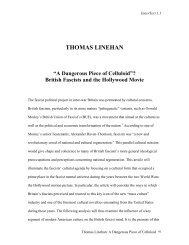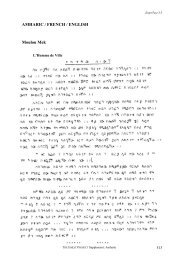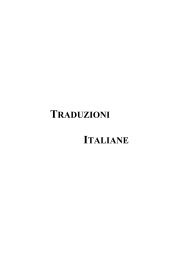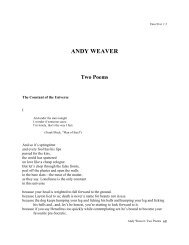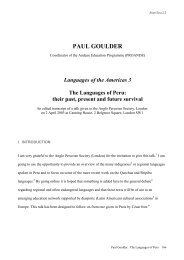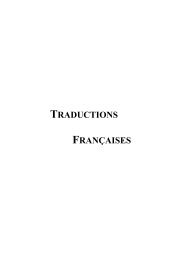Thomas Lamarre: An Introduction to Otaku Movement - Arts @ Brunel
Thomas Lamarre: An Introduction to Otaku Movement - Arts @ Brunel
Thomas Lamarre: An Introduction to Otaku Movement - Arts @ Brunel
Create successful ePaper yourself
Turn your PDF publications into a flip-book with our unique Google optimized e-Paper software.
EnterText 4.1<br />
otaku kara mita Nihon shakai (<strong>An</strong>imalising Postmodern: <strong>Otaku</strong> and Postmodern<br />
Japanese Society, 2001). His contribution <strong>to</strong> the catalogue for Murakami Takashi’s<br />
Superflat exhibition makes important connections between Murakami’s art and his<br />
theories.<br />
Despite some obvious differences in emphasis, Murakami and Azuma show a<br />
common understanding of what anime is, and how it works—much of it consonant with<br />
Okada and Gainax, and sometimes clearly derivative from them. Generally, the<br />
theoretical emphasis of Azuma’s work draws out many of the implications of what I call<br />
the “Gainax discourse.” The regularity of such statements about anime and otaku is such<br />
that one might even speak of a “discourse” on anime in the Foucauldian sense, insofar as<br />
such statements do seem <strong>to</strong> imply some relation <strong>to</strong> the institutional regulation of anime<br />
entertainment. 10 My goal, however, is not <strong>to</strong> trace the origins of the Gainax discourse on<br />
anime and otaku. Nor is a full treatment of the ways in which these discussions connect<br />
<strong>to</strong> other discourses in Japan within the scope of this paper. What interests me about these<br />
different discussions of anime is the emergence of a common sense of how the anime<br />
image works, particularly in relation <strong>to</strong> the formation of a specific kind of cult fan, the<br />
otaku. Central <strong>to</strong> this discourse is the identification of a “distributive visual function,” a<br />
sort of constituent power of anime as a visual field. But let me begin by sketching some<br />
ideas about anime common <strong>to</strong> Azuma Hiroki, Murakami Takashi, Okada Toshio and<br />
<strong>An</strong>no Hideaki.<br />
First, these discussions share a sense of the genealogy of anime. They try <strong>to</strong><br />
define anime in a narrower sense, locating its origins in the Japanese styles of limited<br />
animation first evidenced in Tezuka Osamu’s Tetsuwan A<strong>to</strong>m (Astro Boy, 1962), an<br />
<strong>Thomas</strong> <strong>Lamarre</strong>: <strong>Otaku</strong> <strong>Movement</strong> 156



